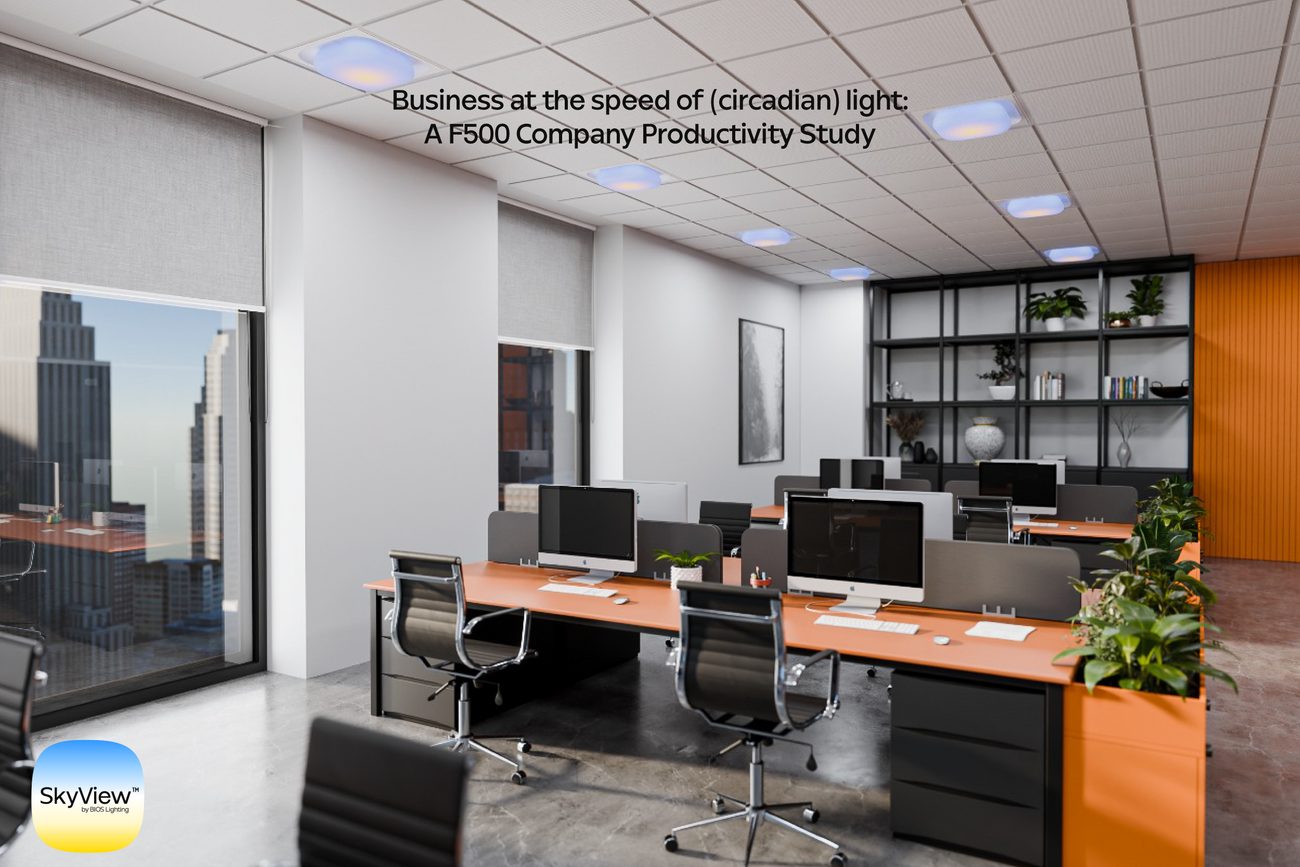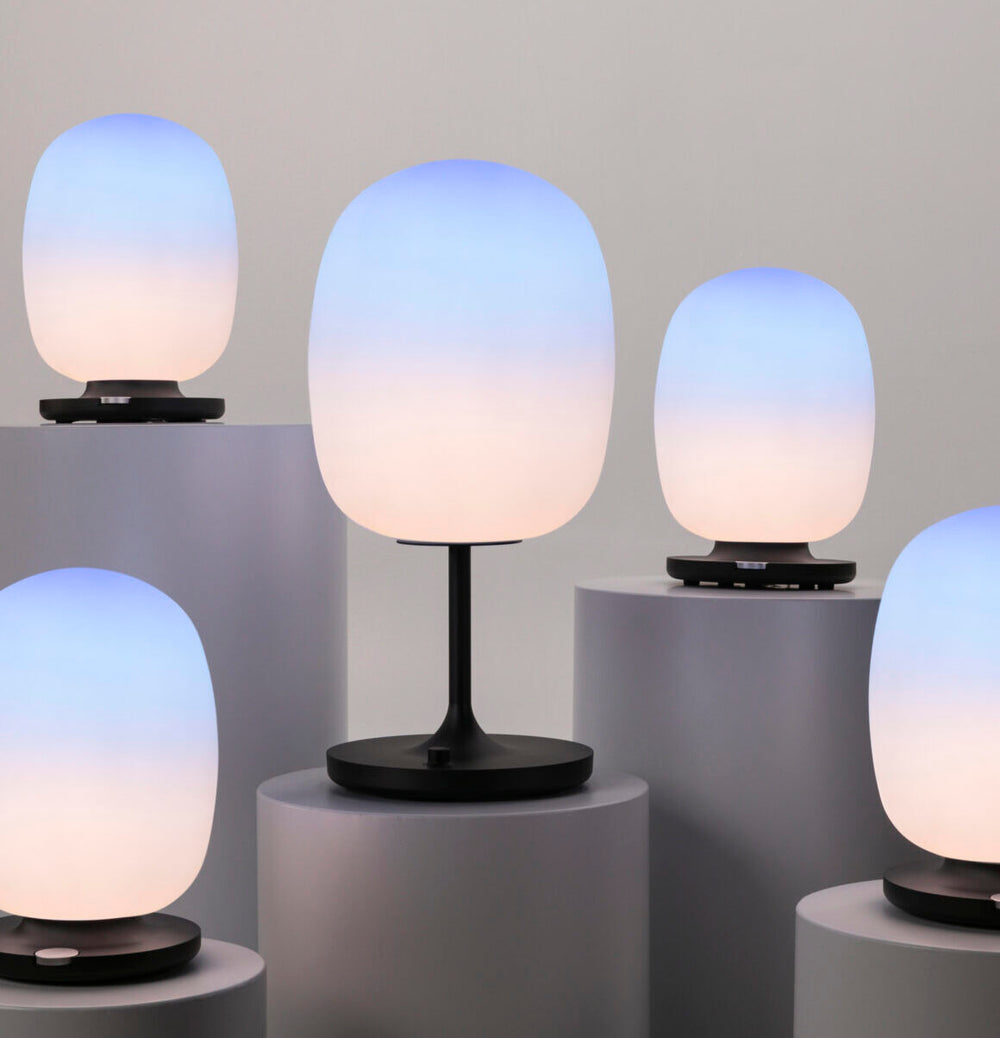How SkyView™ Circadian Lighting Brings the Feeling of a Blue-Sky Day into the Office

Blue-sky days often bring a palpable feeling of vitality and wellbeing you long for deep in your otherwise bright office. The primary purpose of indoor lighting was originally to provide sufficient illumination for visually directed tasks in environments where natural light was insufficient. However, extensive research shows that standard electric lighting is a weak and insufficient source of the light spectra that plays a much greater role in human health, influencing mood, focus, alertness, and overall well-being. Office workers, who spend a significant portion of their day under electric lighting, stand to benefit immensely from circadian lighting—light that mimics the natural light spectra of the sun and sky to bring that blue-sky feeling indoors.
The Benefits Circadian Lighting in the Workplace
Enhanced Alertness and Cognitive Performance
One of the primary advantages of circadian lighting is its ability to improve alertness and cognitive function. Studies show that exposure to blue-enriched light in the workplace can enhance wakefulness, reduce drowsiness, and increase focus. The effect is particularly pronounced in environments requiring sustained attention and precision, such as high-paced office environments, call centers, control rooms, and research facilities. Research also indicates that higher melanopic (blue-sky) light during work hours is associated with reduced subjective sleepiness and increased vitality among office workers. Employees exposed to such lighting report greater energy levels throughout the day, maintaining focus and feeling of productivity from morning through the afternoon.
Improved Mood and Well-being
Beyond enhancing wakefulness, circadian lighting has been linked to improved mood and emotional well-being. Blue-enriched lighting has been found to reduce depressive symptoms, boost serotonin levels, and increase overall feelings of well-being. Field studies found that workers exposed to bright light during winter experienced improvements in mood, energy, and feeling productive —effects that can be particularly valuable for individuals suffering from Seasonal Affective Disorder (SAD).
Increased Feeling of Productivity and Reduced Absenteeism
By promoting alertness and better sleep, circadian lighting can contribute to perceived boosts in workplace energy and productivity. Studies show that employees under circadian-optimized lighting conditions experience fewer errors, better task performance, and reduced fatigue. Moreover, since insufficient or overly bright office lighting can lead to issues like eye strain, headaches, and sleep disturbances, implementing circadian lighting can help reduce absenteeism related to health concerns.
Better Sleep and Work-Life Balance
Exposure to appropriate lighting during the day can have a lasting impact on sleep quality. By reinforcing natural circadian rhythms, well-designed office lighting can help employees fall asleep at night more easily and enjoy more restorative sleep. Improved sleep, in turn, leads to better performance, emotional stability, and overall health, creating a positive feedback loop between work and personal well-being.
The Challenge of Bringing Outside Light into the Office
Outdoor light exposure can range from 2,000 to 100,000 lux, whereas typical office environments provide only around 300 lux (30FC)—often with limited blue-wavelength content. Building design often includes extensive use of windows, skylights, and other natural light conduits that augments standard electric lighting. However, research shows that while such design features provide good general and melanopic illumination to occupants close by and facing the source, the overall contribution diminishes rapidly after six feet from the pane. Illuminance via skylights is heavily dependent on the light well architecture that limits overall melanopic exposure. Field observations show that window and skylight sources are often either insufficient or too bright/glary resulting in extensive use of shades or louvers that effectively limits the overall room illuminance but greatly diminishes the needed blue-sky spectra. In addition, studies have shown that latitude, seasons, weather, building orientation, and obstructed views also significantly affect melanopic light exposure.
Bright, high correlated color temperature (CCT) electric lighting can also benefit office workers but at a steep price. Research suggests that 17,000K lighting can be more than twice as effective at achieving non-visual biological effects than standard office lighting. However, high CCT light is often reported in field studies as too harsh, cold, or sterile for normal work environments. More acceptable color temperatures around 4500-6500K are sometimes employed in the office but must be significantly increased in intensity (and energy usage) to provide adequate melanopic light. The result again is a less pleasant, glary environment.
Since the governing scientific, medical, and building illumination organizations coalesced on a minimum of 250 melanopic Equivalent Daylight Illumination (mEDI) for daytime lighting as specified in the IES guidelines (RP-46-23), lighting designers and specifiers have been struggling to meet the wellness and energy-efficiency criteria while maintaining a pleasant and motivating office environment. Fortunately, recent advancements in LED spectral tuning combined with an innovative nature-inspired light fixture design have made it possible to achieve circadian benefits without compromising comfort or efficiency.
SkyView™ Tile: A Breakthrough Innovation in Circadian Lighting for Offices
SkyView™ Tile, featuring patented Gradient Circadian Optimization (GCO™) technology, brings the essence of a blue-sky day indoors. It spatially separates CCT, ensuring high color temperatures are visible on the vertical plane (biologically effective) while task lighting remains a warm 3500K (visually comfortable). Installed on a 10’x10’ grid, it delivers 30 foot-candles on task surfaces, 250 m-EDI at eye level, and operates at 0.4 W/sqft—meeting RP-46 standards efficiently.
SkyView™ Tile technology has been shown to enhance mood, focus, and alertness—boosting feelings of productivity by up to 12.5%—making it ideal for offices, schools, and shared spaces. Designed for easy retrofitting, it replaces conventional 2x2 fixtures or integrates seamlessly into existing layouts, ensuring alignment with RP-46 and WELL Building recommendations. By bringing the benefits of a blue-sky day indoors, SkyView™ Tile represents a transformative step in human-centric lighting design.
A Practical and Efficient Biological Approach to Workplace Lighting Design
Historically, human productivity has been viewed through the lens of strategy, technology, and management practices. However, recent breakthroughs in biological sciences underscore the importance of environmental factors—such as lighting—in optimizing human performance. Just as awareness of diet, exercise, and stress management has grown, understanding the role of light in health and productivity is becoming a key consideration for businesses.
As organizations increasingly recognize the impact of circadian lighting, SkyView™ Tile provides an easily implementable opportunity to enhance workplace wellness by providing every worker anywhere in the building the natural light spectra our mind and bodies crave. By aligning office lighting with the body's natural rhythms, businesses can foster a healthier, more engaged, and more efficient workforce.
Shop SKYVIEW Products
Shop Now


